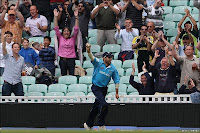This is part of an article I wrote for 'All Out Cricket' magazine last year which named my top 10 cricketers outside of Test cricket nations. I have now taken this a step further and below is my 2011 non Test playing nation world cup squad. Unfortunately this maybe the last time they get to compete at the highest level, due to the 2015 world cup only consisting of Test playing nations.
 1 - Trent Johnson
1 - Trent JohnsonIreland, New South Wales, Mosman
Age: 36
Role: Allrounder
This man has leadership qualities in abundance. The Aussie moved over to Ireland after a career playing for New South Wales. In the 2007 world cup he captained Ireland causing the biggest upset in world cup history when the 'Blarney Army' saw off Pakistan.
2 - Gerrie Snyman
 Namibia
NamibiaAge: 29
Role: Allrounder
After taking the prize wickets of Andrew Flintoff and Paul Collingwood in the 2003 world cup, this hard hitting all rounder has gone from strength to strength. Although he has generated interest from county sides, it would mean giving up his national duties for Namibia, something he is not prepared to do.
3 - Boyd Rankin
 Ireland, Derbyshire, Warwickshire
Ireland, Derbyshire, WarwickshireAge: 26
Role: Right Arm Fast Bowler
At 6'8", Rankin is probably the tallest player in Associate/Affiliate cricket. He swapped the life of a cattle and sheep farmer for a professional cricket career and is now contracted with Warwickshire. He finished as Ireland's leading wicket taker in the 2007 world cup with 12 wickets.
4 - Ashish Bagai
Canada
Age: 28
Role: Wicket Keeper/Batsman
 This 'City Slicker' has been combining a high flying banking career at UBS with international cricketing duties for over five years now. After he averaged 86 in the 2007 World Cricket League in Nairobi he was convinced he should take cricket more seriously and has now accepted a professional contract with the Canadian Cricket Board.
This 'City Slicker' has been combining a high flying banking career at UBS with international cricketing duties for over five years now. After he averaged 86 in the 2007 World Cricket League in Nairobi he was convinced he should take cricket more seriously and has now accepted a professional contract with the Canadian Cricket Board.
5 - Nial O’Brien
Ireland, Northamptonshire, Kent
 Age: 28
Age: 28Role: Wicketkeeper/Batsman
Averaging 35 in first class cricket, it was the gutsy Dubliner's match winning 72 that famously beat Pakistan in the 2007 world cup. He is a constant irritation to opposition batters with his endless on field chattering. His transition to the comm box should prove seamless.
6 - David Hemp
Bermuda, Free State, Glamorgan, Warwickshire
Age: 39
 Role: Batsman
Role: BatsmanBorn in Bermuda, bred in the UK. Hemp has amassed an amazing 15,520 first class runs in a highly successful career. As captain of Bermuda this elegant left hander always looks in control. He combines his international duties with his full time job in the UK as Director of Cricket at Solihull School.
7 - Ryan Ten Doeschate
 Netherlands, Essex, Western Province
Netherlands, Essex, Western ProvinceAge: 30
Role: Allrounder
Possessing an ODI average of 68 and a first class average of 49. This South African-raised Dutchman regularly hits balls out of the ground into the river Chelmer when on duty for Essex. He has the enviable reputation of being the most entertaining cricketer playing the game outside of Test cricket.
8 - Lucas Paterlini
Argentina, St Albans
 Age: 28
Age: 28Role: Allrounder
More 'wild child' than 'wild card', Paterlini is South Americas answer to Andrew Flintoff. Where Fred does pedalo, Lucas does Tango. The fiery allrounder is always a menace to top-order, finishing second in the bowling averages at the ICC Americas Division One competition in 2010.
9 - Mohammad Nabi
Afghanistan, Marylebone Cricket Club, Pakistan Customs Age: 25
Role: Right-hand batsman/Offspinner
Born in a refugee camp in Pakistan, Nabi developed his cricket skills with the MCC YCs in 2006. This experience stood him in excellent stead, as he is now a successful international player with an ODI average of 35.
10 - Kyle Coetzer
Scotland, Durham, Scotland Under-19s, Western Province
Age: 26
 Role: Right-hand batsman
Role: Right-hand batsmanThe Scottish top-order batsman has played a key part in Durham’s success in the last three seasons. His quality was highlighted at the top level when he scored 51 against England last summer. He was introduced to the game by Grant Dugmore, the CEO of Cricket Argentina.
11 - Kenneth Kamyuka
 Uganda, JACC, Wanderers, Destroyers, Tornado B, Nile
Uganda, JACC, Wanderers, Destroyers, Tornado B, NileAge: 28
Role: Allrounder
Known as Double Zero due to his 00 squad number he shoots to thrill. The ICC Associate rumour on the street is he is now living in Canada and will be available to play for the ODI nation in 2012.
12 - Sushil Nadkarni
 USA, India Under 19s, Maharashtra
USA, India Under 19s, MaharashtraAge: 33
Role: Left hand batsman
After starting his cricket career for state side Maharashtra in India he immigrated to the States to become an engineer. He has been in the international wilderness until last year he came to prominence for the USA in there vital Division Five win against Nepal where 12,000 people invaded the pitch.
13 - Thomas Odoyo
Kenya, Africa XI, Nairobi Gymkhana, Southern Rocks
Age: 32
Role: Allrounder
Making his debut at the tender age of seventeen in the 1996 world cup, Thomas has played a staggering 126 ODIs. He was the first ICC Associate player to complete the 2000 run and 100 wicket double at ODI level and also once held the ODI record seventh wicket partnership of 119.
14 - Rizwan Cheema
 Canada, Canada A, Ontario
Canada, Canada A, OntarioAge: 31
Role: Right hand batsman
Rizwan made headlines when he scored 89 off 61 balls against the West Indies in 2008. He moved to Canada in the early 2000s after being born and raised in Pakistan. In 2010 he almost made it to the big time when he made the short list for the IPL contract auction.
15 - Nawroz Mangal
Afghanistan
 Age: 25
Age: 25Role: Right Hand Batsman/Offspinner
Since taking over as captain in 2007 he has led Afghanistan to become the first Affiliate cricket nation to gain ODI status. He spent most of his early years in refugee camps after fleeing Afghanistan to Pakistan after the Russian invasion. He has an ODI batting average of 39 and bowling average of 26.












































